Content
Whole grain flour is much superior in nutritional value to high-grade flour ...
Modern technology for making flour means that the grain is first ground and then sieved through a sieve.
The finer the grinding, the more "ballast substances" can be weeded out.
The most "pure", in this sense, flour - flour of the highest grades.
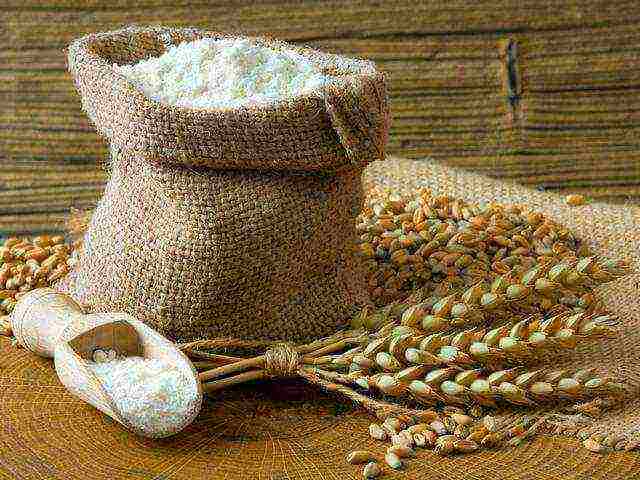
Fine grinding allows you to filter out absolutely all "impurities", including the flower coat and grain germ (vitamins, unsaturated fatty acids, minerals, etc.), including fiber, leaving only pure starch (carbohydrates).
The nutritional value of such flour (the amount of kcal) is really very high. But from the point of view of the biological value of the product, it is a carbohydrate "dummy".
In such flour, nothing useful and necessary for the body remains. He cannot create new cells from carbohydrates, for this he needs all the variety of macro- and microelements laid down in a whole grain by nature.
MODERN FLOUR VARIETIES
Today, modern industry offers 5 varieties of wheat flour:
- grains,
- premium flour,
- flour of the first grade,
- flour of the second grade,
- wallpaper
and two varieties of rye flour:
- sown
- peeled.
All these varieties, both in the past and in the present, differ from each other in the size of the grinding and the ratio of the peripheral parts of the grain (shell and embryo) and flour grain (endosperm).
Wheat flour varieties differ from one another in yield (the amount of flour obtained from 100 kg of grain), color, ash content, varying degrees of grinding (particle size), the content of bran particles, and the amount of gluten.
According to the percentage yield of flour when grinding grain, flour varieties are divided into: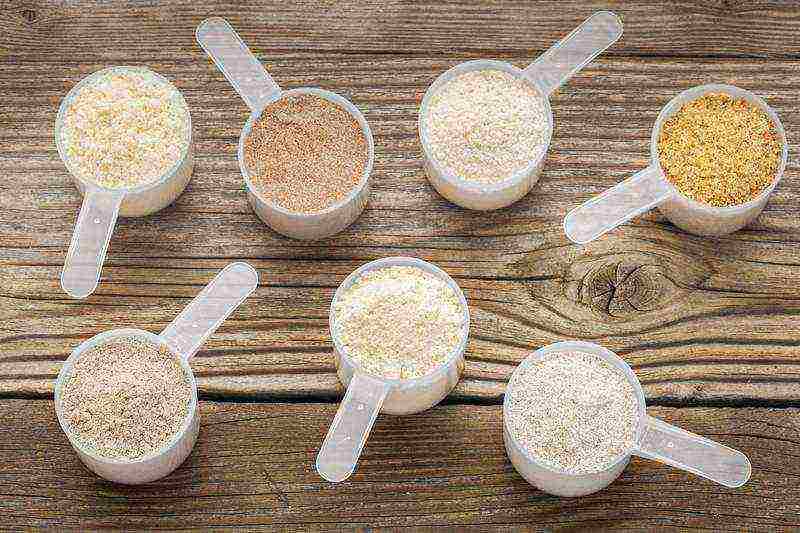
- grit 10% (it is obtained only 10% of the total amount of grain in a volume of 100 kg.),
- top grade (25-30%),
- first grade (72%),
- second grade (85%) and
- wallpaper (about 93-96%).
The higher the flour yield, the lower the grade.
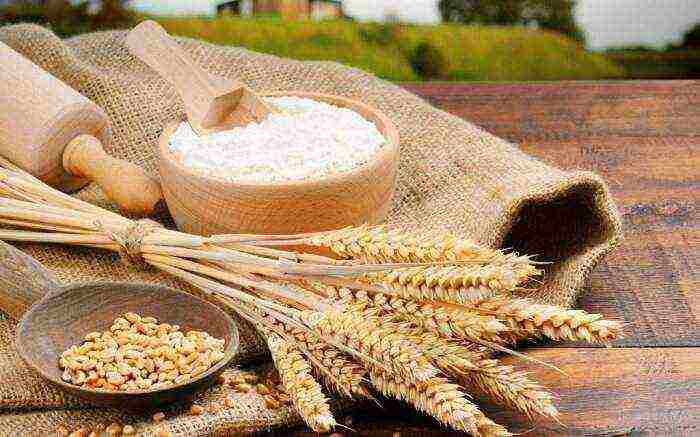
Krupchatka - consists of uniform small grains of light cream color, which are particles of endosperm (grains) with a size of 0.3-0.4 mm, does not contain shells and soft powdery particles.
There is almost no bran in it. It is rich in gluten and has high baking properties. Grit is produced from special varieties of wheat and is distinguished by the larger size of individual particles.
It is advisable to use this flour for products such as cakes, pastries, etc. For unsuitable yeast dough, grit is of little use, since the dough from it is poorly suited, and the finished products have poor porosity and quickly stale.
Flour of the highest grade - consists of finely ground (0.1-0.2 mm) particles of endosperm, mainly inner layers.
It differs from grains in that grains are not felt between the fingers when rubbed.
Its color is white with a slightly creamy shade. Premium flour contains a very low percentage of gluten. The best category of the highest grade is called "extra". Often used as a thickener in sauces and also suitable for baking.
This type of flour is most common in the manufacture of the highest grades of flour products. Wheat flour of the highest grade has good baking properties, products made from it have a good volume and fine developed porosity.
First grade flour - soft to the touch, finely ground, white with a slightly yellowish tinge. Flour of the first grade has a sufficiently high content of gluten, which makes the dough from it elastic, and the finished products are of good shape, large volume, pleasant taste and aroma.
First grade flour is good for uncooked baked goods. (rolls, pies, pancakes, pancakes, sautéing, national types of noodles, etc.), and for baking various bread products... Finished products from it stale more slowly.
Second grade flour - consists of particles of crushed endosperm and 8-12% of the mass of flour of crushed shells. Flour of the 2nd grade is larger than the flour of the 1st grade. Particle sizes 0.2-0.4 mm. The color is noticeably darker due to the high content of the peripheral parts of the grain - usually white with a yellowish or grayish tint. It is white in color with a noticeable yellowish or brown tint, contains up to 8% bran, it is much darker than the first-class. It is light and dark.
Such flour is better in terms of baking qualities - baked goods from it are fluffy, with a porous crumb. It is mainly used for baking table varieties of white bread and non-flavored flour products. It is often mixed with rye flour. This flour is used in the manufacture of some confectionery products (gingerbread and cookies).
Wallpaper flour (wholemeal flour) - is obtained by grinding the whole grain.
The flour yield is 96%. The flour is coarser, the particles are less uniform in size.
It is produced from all types of soft wheat varieties, there are 2 times more bran in it than in flour of the 2nd grade, color with a brown tint. In wallpaper flour, the content of bran particles is the highest.
In terms of its baking properties, it is inferior to high-quality wheat flour, but has a higher nutritional value.
The shells of grain contain protein substances, vitamins of groups B and E, mineral salts of calcium, phosphorus, iron, magnesium. The kernel of the grain is rich in starch and contains significantly less protein and other nutrients than its peripheral layers. therefore flour made from whole grain or with the addition of finely ground bran in their nutritional value is significantly superior to high-grade flour.
Wallpaper flour used mainly for baking table breads, and rarely used in cooking.
Coarse wallpaper flour is the largest flour grinding. Accordingly, the wallpaper flour is sifted through a coarse sieve.
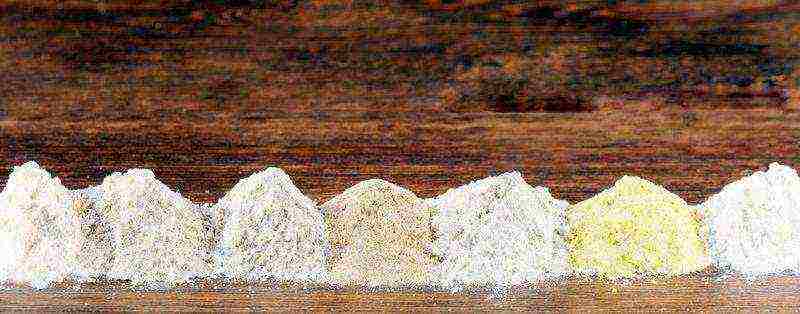
During wallpaper grinding, absolutely all the components of the grain remain in the flour. This is the flower shell of the grain, and the aleurone layer, and the grain embryo. Accordingly, all the biological value of whole grain and all its healing qualities for the human body are preserved in wallpaper flour.
Flour is fine and coarse.
Wholemeal flour - whole grain flour. With coarse grinding, almost all the grain is ground into flour, which consists of large particles, contains cell membranes, bran (2nd grade wheat, wallpaper).
Fine flour Is flour from the endosperm, i.e. the inner part of the grain. With fine grinding, white flour, tender, consists of small particles of grain, the outer layers of which are removed (wheat 1st grade, premium grade). Contains mostly starch and gluten, and virtually no fiber.
The finer the grinding and the higher the grade of flour, the less proteins and especially minerals, vitamins, and more starch in it. As for the terminology, the coarsely ground grain is called meal, and the finer grain is called flour.
Flour obtained from a single grinding can be called "whole grain" (since all parts (100%) of whole grain: fruit and seed coats, embryo, endosperm particles, etc. remain in the flour). However, until recently, it was better known under the names "fodder" or "fodder".
It is worth noting that flour, ground in a mortar, in a coffee grinder or on the rollers of the grinding system at a mill, will be very different from each other, and their baking properties will also differ.
Flour is an essential ingredient used not only in baked goods. The product is also actively used for the preparation of second courses, so maximum attention should be paid to the correct choice of this component. It's no secret that fluffy bread, mouth-watering buns or brown pancakes are made only from the highest quality flour. The stores sell a variety of options, so it is important to know what to prefer - extra or premium flour.
Baking: choosing the right base
Flour should be chosen, focusing on the dish to be prepared with its use, since for sweets - cakes, pastries and pastries with a high sugar content, you should select the highest grade, for pancakes and other savory pastries - extra.
IT'S IMPORTANT TO KNOW!
To lose weight in 30 days, you need to apply 3 important processes: preparation ..
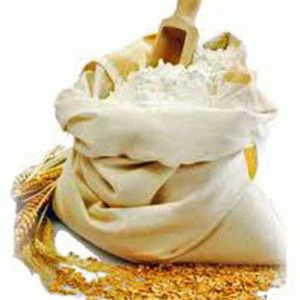 Now you need to figure out how the premium flour differs from the extra one. Despite the name, the premium flour is not the best in the general sense of the word. It is important to take into account the taste of the product, the nutritional value, both in sweet and savory pastries and second courses.
Now you need to figure out how the premium flour differs from the extra one. Despite the name, the premium flour is not the best in the general sense of the word. It is important to take into account the taste of the product, the nutritional value, both in sweet and savory pastries and second courses.
This type of flour is made from wheat grains, but not whole, but containing the least amount of vitamins. There is more starch in the premium grade than in other types of flour. Therefore, the choice in favor of the highest grade should be made only when it is planned to make sweet pastries, cakes or dessert pies. The grind type is fine, so it is impossible to see foreign inclusions or grain particles. The pomp indicators are excellent, the color is uniform white.
You can also buy first grade flour in stores. It is sometimes mistaken for the highest. However, the grinding is coarser in this case. This flour is suitable for those who appreciate the presence of nutrients and vitamins in the product, since the composition includes grain shells containing all the necessary trace elements. This flour is most often used by professionals and experienced chefs for savory pastries, pies with meat or vegetable fillings, and also kulebyak.
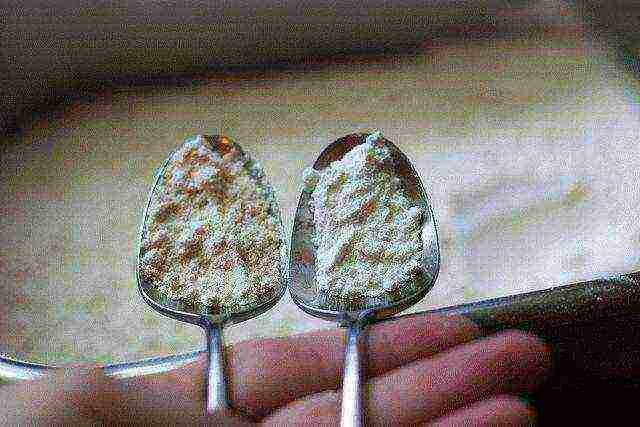
Extra is a variety that is actively used in the confectionery industry. Therefore, at home, it is preferable to choose it when it comes to sweet products, pies with fruit or berry fillings.
Features of flour grade "Extra"
In order not to be mistaken in the choice of flour, you need to know its main characteristics. About the extra variety:
- Gluten contains 28%;
- Starch - more than 80%;
- Ash content - 0.45%;
- The energy value of the product is 334 kcal.
It is also important to know that according to storage standards, the shelf life of such flour is six months. The optimum temperature is +20 degrees, and the humidity is 70%. Choosing this variety will allow you to create delicious homemade cakes, including sweet pancakes.
Other types of flour
In addition to the premium and extra, there are other types of flour, which you also need to know about when making a choice of product:
- The second grade is coarse flour. It contains not only the grain, but also the shell from it. The color, accordingly, will not be white, most often it is gray-cream. A similar flour is used to make pancakes, and dumplings are also made from it. Since the dough turns out to be coarse, it is not used for baking. Another name for this variety is pancake;
- Whole grain (wallpaper) - a variety that is produced using grains, wheat germ, shells. These parts are considered the most valuable, as they are full of vitamins and minerals, which are very beneficial for the body. This variety is used in its pure form only for making bread, but if you add extra or premium flour, you can safely bake various buns.
It is also important to know that high-quality flour, regardless of the variety, should not contain preservatives in the composition. For Extra and premium grades, colors from white to white - cream are allowed. You can check the quality of purchased flour by adding a few drops of plain water to 1 tablespoon. In the event that it does not change its color, a quality product was purchased.If a reddish tint appeared - bran is present in the composition, blue - unripe wheat was used.
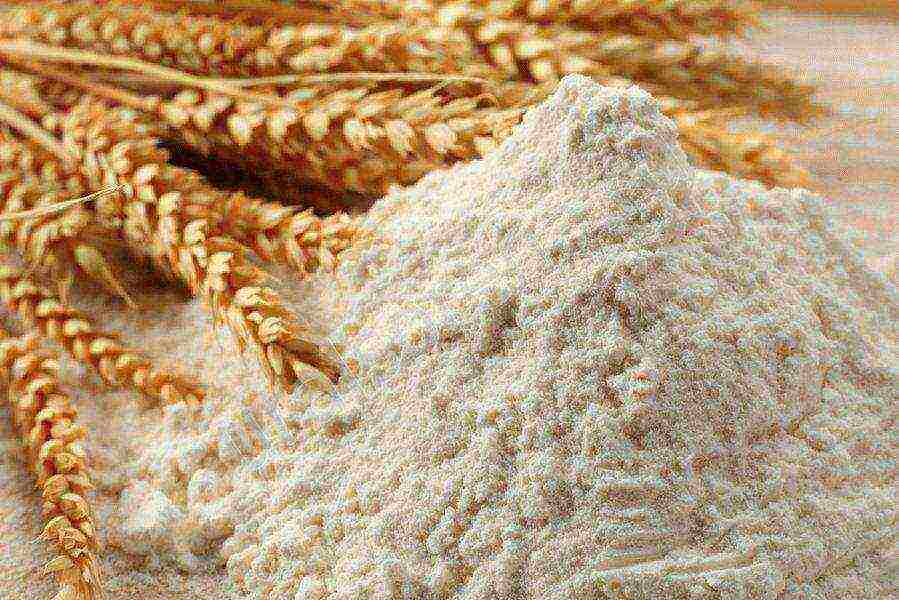
When choosing flour, you can verify its quality by touching the product. If you squeeze it in your hands, you should hear a slight crunch. Damp flour is determined by the presence of lumps remaining after compression. In addition, the smell of flour should be pleasant. A quality product will not have a putrid or sour aroma. You can try flour - good flour will not creak and crunch on your teeth. If such manifestations are present, this may indicate that additional components (additives and food impurities) are included in the composition.
You can confirm the high quality by applying the appropriate labeling to the packaging. The bag in which the product is stored must be made exclusively of paper. This will allow for good natural ventilation, which will prolong the freshness of the flour.
In addition to wheat flour of the highest grade and extra, there are also:
- Buckwheat - it has no stickiness, contains B vitamins and vitamin PP, as well as substances such as fluorine, copper and potassium;
- Corn. It is used in many dishes such as hominy and polenta. Also cakes and bread are baked from it. Corn flour is a good folk remedy for anemia, the product stimulates bile secretion and intestinal peristalsis, helps to normalize blood circulation, strengthen the heart and blood vessels, and slow down the aging process. It removes fat accumulations from the body.
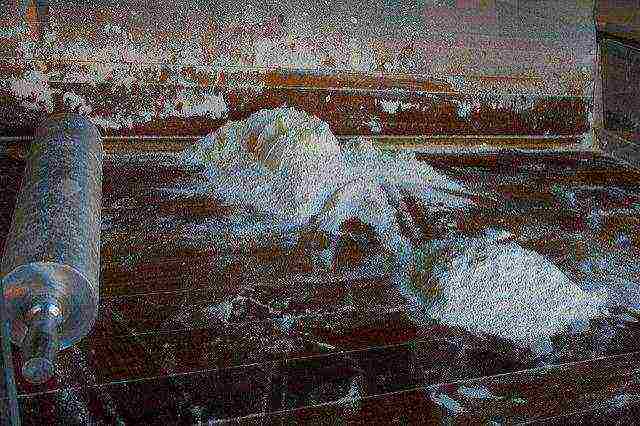
Chickpea and flaxseed flours have good sticky properties, so they are ideal for baking without eggs. Chickpea flour, in turn, is a good source of substances such as potassium, calcium, zinc and protein. It contains a lot of soluble dietary fiber, the so-called complex carbohydrates, which the body needs for stable work and overall health.
Millet flour contains little gluten. It contains B vitamins and vitamin PP, which strengthen the nervous system, stimulate memory. In turn, fluoride, magnesium, iron, calcium strengthen bones and teeth, make hair shiny and strong and restore normal metabolism.
Product storage
In order to preserve the product for a long period, it is important to know how to do it correctly. The main problem for housewives is that various insects start up in the flour, in order to prevent this, it is enough to put 1-2 cloves of fresh garlic next to the package.
Maintaining optimal moisture levels is also one of the prerequisites to keep the quality of the product at a high level for the entire period indicated on the package. An ordinary bay leaf, which should be placed next to it, will allow you to remove excess moisture. You should also not stock up on flour in large quantities (unless it is used daily for baking).
Thus, which grade is better, the highest or the extra, is decided exclusively by the person, based on the basic actions that he will perform with this product.
Of course, you can carefully read the composition (if specified). Study the expiration date: Experienced housewives say that the best flour is the one that was made a week or at least a month ago. But by and large, these two parameters do not guarantee successful pies. Flour from the same manufacturer, with the same name, can be different. At the exit, the quality will depend on how the flour was ground, and on what it was transported in, where it was stored. In one store, the batch will lie in a dry room on wooden pallets, in another - on the floor in a damp basement, and now someone will get airy flour, crumbly, and someone - with lumps. To figure out whether it was lucky this time or not, it will turn out only at home. After…
✓ Open the package and carefully look at its contents. Flour of the highest grade (this is what our today's expertise is devoted to) - snow-white or with a cream shade, there are no lumps or impurities in it.
✓ Smell the flour. The right flour smells like endless fields, free wind and bottomless sky with cloud feathers. And the wrong one - a musty basement ...
In general, if it has deteriorated, you will definitely feel it. Flour, by the way, easily absorbs odors. Therefore, if it was stored or transported with something wrong, you will also unmistakably determine that.
✓ Touch. The good-quality flour is dry and silky to the touch. It sticks to your hands, and if you squeeze it with your fingers, it crunches melodiously.
✓ Try it. To taste, the correct flour is almost bland or slightly sweetish, without a bitter or sour aftertaste. If it crunches on the teeth, there is sand or other mineral impurities in the flour - they come from poorly refined grains, which, of course, is unacceptable.
Important indicators
In laboratories, in order to determine the quality of flour, it is not only sniffed and touched, but also passed through devices and sifted. As a result, such parameters are added to taste and smell as ...
1. Moisture content. If this figure is too high, the flour can quickly deteriorate. Ideally, humidity should not exceed 15%.
2. Coarseness of grinding. Fine flour absorbs moisture faster, which means that the dough kneads and fits faster.
3. Falling number (NP). Knowing it, you can predict how the bread crumb will turn out. With an emergency of less than 250 seconds, the crumb will stick together, and the bun itself will turn out to be low. In case of emergency for about 250 seconds, the crumb, if you press on it with your finger, will quickly restore its shape. But with an emergency of about 400 seconds, it will be dense, and the bun will be firm and, moreover, with an unimportant taste.
4. Mass fraction of gluten. The higher the grade of flour, the more gluten it contains and the more magnificent the baked goods are. In premium flour, gluten is 28% or more, in general-purpose flour - about 23%, and buns made from it are not so airy (however, this flour is healthier).
Five varieties of wheat flour
Krupchatka. It is produced from special varieties of wheat and has a large particle size. Rich in gluten, suitable for baking cakes and pastries. But the uncooked yeast dough made from such flour does not work well, besides, the bread quickly becomes stale.
Flour of the highest grade. It has the finest grind and the whitest color. It has a very low percentage of gluten. It is used as a thickener in sauces and is also suitable for puff pastry, shortcrust pastry and yeast dough. Ideal for baking bread.
First grade flour. Compared to premium flour, it contains more sugars and fiber. Suitable for uncooked pastries - rolls, pies, pancakes. Products from it do not stale longer.
Flour of the second grade. Contains up to 10% of grain shell particles. Suitable for baking table types of bread and uncomfortable flour products. It is often mixed with rye flour.
Wallpaper flour. It has the coarsest grind and is made up of all parts of the grain, which is why it is commonly referred to as whole grain. For obesity, diabetes and heart disease, doctors advise eating bread from this flour.
How it all began
The very first device for making flour was a grain grater - a primitive mechanism of two stones, between which grains were ground. The first mills appeared 3-4 thousand years ago. At first, they were rotated by slaves and pets, then they began to use the energy of water and wind. In the 18th century, Scottish mechanic James Watt "crossed" the mill with the steam engine he invented. In 1822, Mark Miller from Warsaw made a fundamentally new flour mill, replacing stone millstones with light rollers - hollow metal drums, between which the grains were ground into flour. This technology is still used today.
A word to an expert
Tatyana ANOKHINA, head of the testing center of the SEAC "SOEKS" of the Chamber of Commerce and Industry of the Russian Federation.
Wheat flour of the highest grade is the “poorest” one. It is extremely low in protein, vitamins and minerals. But it is the most popular, and only from it lush biscuits and mouth-watering buns are obtained.Six samples of such flour have been tested in our laboratory. In terms of safety indicators, all of them comply with the requirements of the technical regulations of the Customs Union TR CU 021/2011 "On food safety", all comply with the requirements of GOST R 52189-2003 "Wheat flour. General technical conditions ". We did not find any foreign impurities or GMOs of plant origin in them. It was extremely difficult to choose the winners: the subjects were very worthy. We were able to determine the first, second and third places only when we summed up the best indicators. As a result, the gold went to Makfa flour, silver to Sokolnicheskaya, and bronze to Nordic, largely due to the fact that this flour is made from organic grain.
Text by Evgeny Danilov
Test: wheat flour *
| JSC "Melkombinat in Sokolniki", Moscow | JSC "MAKFA", Chelyabinsk region | OJSC "Lukhovitsky flour mill", Moscow region | ZLAK Combine of Bread Products, Chelyabinsk Region | JSC "Petersburg Mill Plant", St. Petersburg | Finland |
| 12 months | 12 months | 6 months | 12 months | 12 months | 12 months |
| Not detected | Not detected | Not detected | Not detected | Not detected | Not detected |
| 55 | 58 | 56 | 54 | 54 | 55 |
| 10,6 | 11,3 | 11,6 | 10,9 | 14 | 11 |
| 30 | 33 | 28 | 28 | 30 | 28 |
| 318 | 524 | 413 | 397 | 394 | 396 |
| 1 | 0,5 | 0,9 | 1,5 | 3,5 | 2,2 |
| Sokolnicheskaya will be stored longer than competitors - it contains very little moisture. Add to this the excellent grind and the best falling number (it affects the quality of the future crumb), and it turns out that this contestant is one of the best today. | This flour is the leader of today's competition. Moreover, it is the leader in several indicators at once: whiteness, grind size, gluten content. Baking from it will turn out soft and fluffy. Congratulations to the winner! | The shorter the shelf life, the better. This rule does not apply to flour. It is usually stored for a year. Lukhovitskaya is slightly inferior in terms of indicators to most of the competitors - perhaps that is why the manufacturer has reduced its shelf life. | The grinding coarseness and moisture content of this flour are at a height, but the rest of the indicators are average. Before us is such a classic middle peasant. For such a price - quite a satisfactory result. | This flour has the largest grind, which means that the dough from it will ripen longer. The moisture content is also quite high. But this does not mean at all that this flour is of poor quality. All her indicators are within the normal range. | It's nice that this flour is organic (hence such a high price). You can eat homemade buns and think that they are healthier than those that Aunt Klava's neighbor has. Perhaps, this contestant is no different from the others. All indicators are average. |
* Thank you for your help in conducting the SEAC "SOEKS" test
What is flour? Flour is a food product obtained by grinding grain into a powdery bulk mass. Flour is divided by type, type and grade, depending on the type of grain used, into types according to purpose, grades in accordance with the fineness of grinding and varieties of grains for making flour.
Flour, as you know, is a valuable food product, and without it it is impossible to bake bread, make a homemade pie, or make fluffy pastries. Knowing the types of flour, what varieties and types there are, what to look for when choosing, how to properly use flour for its intended purpose, you can learn how to independently classify flour products and cook tasty and healthy food with flour.
Testimonial advises. The darker the flour, the more it contains substances useful for the human body: proteins, minerals and vitamins.
In the milling industry, flour is made from various agricultural crops, mainly cereals. Flour is produced mainly from varieties of grain crops such as wheat, rye, barley, spelled, oats, buckwheat, corn, millet and rice.
In addition to those listed, there are other types of flour, but the bulk is made from wheat. Wheat flour is the basis of dough for bread, bakery products and is classified by grade.
What are the varieties of flour
The type of flour is determined depending on the yield (receipt) of the finished product from the grain. The flour yield is calculated as a percentage. The more flour comes out of the grains, the lower the grade and coarser flour is. If you grind 10 kg of grain into flour, then you get 8.5 kg of the finished product, and the flour yield will be 85%. The lower this percentage, the higher the grade of flour.
An indicator of the quality of flour, its types and types, is considered a grade. In the production of bread, as a rule, rye flour and wheat flour are used. Flour from cereals and cereal crops is included in composite mixtures and is used as an independent product.
Flour composition and properties
Flour, consisting of various impurities, has a valuable nutritional composition, enriched with dietary fiber, vitamins, macro- and microelements, is used to improve the taste of flour products and increase the energy value of the product.
When choosing flour in a store, pay attention to the packaging. On the packaging with high-quality flour, the composition should be indicated. If the flour consists of composite mixtures, read the information on the package about the composition of the mixtures, their percentage in the flour. Pancake flour, for example, contains additional ingredients such as milk powder, salt, sugar, baking soda, and dry egg powder.
Flour from various grains, from a mixture of wheat and rye (wheat-rye), from one culture has an unequal composition, we present the general indicators of the chemical composition of flour:
- starch - 54-90%;
- proteins - 14 (wheat) -44 (soy)%;
- fats - 0.9-4%;
- carbohydrates;
- cellulose;
- vitamins - B1, B2, B6, PP, A, E;
- dextrins;
- enzymes;
- minerals - 0.36-3.5%.
Flour is divided depending on its main properties, in accordance with nutritional value, composition, technological features, taking into account the raw materials used and grain grinding. Flour is classified by types and types.
Types of flour
The type of flour is simply determined by its intended purpose. Wheat flour is divided into three types, it can be:
- Bakery - a type for baking bread.
- Pasta is a type of flour used to make spaghetti and pasta.
- Confectionery - for making cakes, pastries and muffins.
Meanwhile, not all flour is intended for baking, not all types of flour are used in baking. Buckwheat flour and oatmeal are widely used in the preparation of nutritional formula for children, baking pancakes, pancakes and cookies.
Rice flour is used for breading fish, meat and vegetables. Porridge is cooked from corn flour, casseroles are prepared. But wheat flour is considered the leader in production and consumption among other types of flour. What flour is usually made of:
- Wheat bread flour is made from soft wheat.
- Wheat pasta flour is obtained from durum grains.
- Rye flour is only used for baking. The main feature of the composition of rye flour is the high content of proteins, carbohydrates and mucus.
Flour is coarse and fine
Fine flour - flour from the inside of the grain. When finely ground flour is white, it usually contains gluten and starch, fiber in white flour contains a small amount. Fine grinding makes the flour tender; such flour consists of small particles of grains, the outer layer of which is removed. Wheat flour is considered to be flour:
- Top grade;
- First grade.
Coarse flour - whole grain flour. When coarsely ground, the whole grain is completely ground into flour. It consists of large particles, in its composition bran and grain shells. Wholemeal flour:
- Wallpaper;
- Second grade.
Wheat flour: varieties and calories
Wheat flour is produced from wheat grains, the main purpose of the product in ready-to-ground form is to use it for baking bakery products and bread. Wheat baking flour is divided into grades:
- grains;
- top grade;
- first grade;
- second grade;
- wallpaper flour.
In addition to the main 5 varieties, Podolskaya wheat flour, special baking wheat flour of the highest and first grade are produced.
Wheat flour varieties differ among themselves in the main indicators that have a different effect on the finished flour variety:
- color, smell and taste;
- humidity and zoning;
- type of grinding;
- the amount of bran particles content;
- pest infestation;
- acidity;
- the amount of gluten.
Energy value of wheat flour, composition of BZHU:
- Proteins: 10, 8 g;
- Fat: 1.3 g;
- Carbohydrates: 69.9 g.
The calorie content of wheat flour is 334 kcal per 100 g.
Rye flour: composition and varieties
Rye flour is of three types:
- Seeded. Seeded rye flour of white color with a characteristic cream shade. It is produced from the middle of the grain and consists of small particles.
- Rough. Peeled rye flour - white with a grayish tinge with particles of grain shells. Bread made from such flour is low-calorie, porous and tasty. Contains vitamins and minerals
- Wallpaper. Nutritionists consider rye wallpaper flour to be the most useful for human nutrition, nutritious. It has the highest bran content in comparison with other varieties. Flour of gray color with particles of grain shells. Used for baking bread.
The difference between varieties of rye flour and wheat flour is in the content of bran, the degree of grinding and the amount of product in the output. The less bran in rye flour, the lighter it is. But proteins in rye flour do not form gluten, unlike wheat proteins.
When making dough, rye flour absorbs more liquid than wheat flour. Bread made from rye flour turns out to be black and dense, gray dough, when kneaded, has a tendency to stick to your hands.
Apart from the basic types and grades of flour, there are many different types.
Types of flour
Flour of other types is produced in smaller quantities than wheat flour. The flour used in baking is regular wheat flour. But some recipes include corn, barley, pea and soy; such flour is more often used in the preparation of traditional national dishes. Rice and buckwheat flour is used for baby food, dietary meals, separately as an independent product or in combination with wheat flour.
Different types of flour combined with other dough ingredients give different results. If a certain type of flour is indicated in the baking recipe, it cannot be changed to any other type and variety. The simplest and most common flour for baking bread, pies, rolls and pies is wheat flour.
To bake yeast bread at home, make your own homemade cake, make dough for Italian pizza, extract-free yeast filo, Austrian apple strudel, you need to understand what kind of flour, its type, type and variety, for which baking is suitable.
It is generally accepted to consider ordinary flour of the 1st grade from wheat, sold in stores, but in addition to a simple product, other types of flour can be found on sale under unusual names:
- Semolina is a type of flour obtained from durum wheat, a characteristic feature of the product is the high content of gluten in the composition. Wheat grain semolina is used to make traditional Italian pasta. There is wheat, rice, corn flour, semolina is produced from any grain - corn, rice, wheat and others. Depending on the type of grain, the semolina is assigned an appropriate name.
- Spelled is a type of flour made from spelled wheat. Flour is used for baking, it is produced from wheat, but differs in nutritional value, easily digestible fats in its composition, in contrast to ordinary wheat flour. Spelled flour contains gluten, but tastes similar to whole wheat flour.
- Flour from the Abyssinian duster is a type of flour made from an old type of grain under the unusual name Abyssinian duster. Such flour has a valuable composition and is very nutritious, in appearance it resembles grains of quinoa or millet.The composition of the small grains of the Abyssinian teat contains iron, calcium, thiamine, and fiber. The protein content is higher than in wheat flour, from small grains the flour is gluten-free. The product has gained popularity with gluten intolerance sufferers, athletes and weight watchers.
Whole grain flour
Whole grain flour, or wallpaper, is a product of coarse grinding, produced from whole grains of wheat. Wallpaper flour contains more fiber, nutrients than white, and less gluten. Whole grain baking flour is most often used in a mixture with bakery flour in making bread doughs.
Flour of the 1st (first) grade
Flour of the first grade is also called universal. It is this kind of flour that is most often bought in baking shops. Flour of the 1st grade is a mixture of soft and durum wheat flour. Premium flour is white and darker. White flour is used to bake pancakes, cookies, waffles. The darker one is used in the preparation of yeast-free and yeast-free pastries: breads, casseroles, puddings, sweet pastries, puff pastry and profiteroles with eclairs.
Flour of the 2nd (second) grade
Grade 2 flour is good for baking. Wheat flour with a high (from all wheat flour) starch content and a low protein value. A finished bun made from second-rate flour is obtained with a delicate fluffy texture. Suitable for muffins, muffins, lush cakes and yeast-free breads.
Flour of the highest grade bakery
Flour of the highest grade - white flour from durum wheat. Due to its high gluten content - up to 14% - premium flour is ideal for yeast baked goods. It is rich in protein, as a rule, it contains ascorbic acid, thanks to the acid content in combination with yeast, products made from premium flour are porous and fluffy.
Krupchatka
Small grains without shells and powdery particles - grains. Flour is produced from special varieties of wheat, in the composition there is a lot of gluten, due to which gritty material differs from other flour by its high baking properties. Flour is used for baking such products as pastries, cakes, it is suitable for yeast dough, noodles, dumplings, but not for yeast-free bread.
The benefits and harms of wheat flour
The benefits and harms of wheat flour depend on the amount of baked goods eaten by a person. For flour to be beneficial, not harmful, it is necessary to choose the right types of flour for baking. Snow-white flour is the most useless for human health. White flour is a high-carbohydrate product, using which in excessive quantities, a person gets fat, a bun or pie eaten is quickly deposited in fat, causing harm.
Nutritionists, adherents of proper and healthy nutrition, recommend adding the first grade, second or whole grain flour to high-grade flour when baking products. Baking from a mixture of several varieties of flour will reduce the harm of high-quality wheat.
How to store flour
- The storage of any flour must be correct. It is necessary to store flour in a dry, cool and ventilated area.
- The shelf life of flour is indicated on the package, as a rule, it does not exceed 6 months.
- Whole wheat flour keeps better in the refrigerator.
- Flour should be stored in a closed jar, container for bulk products or sealed packaging. This storage method will help to protect flour from bugs and odors.
- In the hot season, it is better to place any flour in the refrigerator, otherwise it will quickly turn rancid at high temperatures in the kitchen.
- It is forbidden to eat flour if it has changed color, there is a foreign smell, bugs.
- You should buy flour as it is consumed, there is no need to stock up for future use.
Which gluten-free flour is best for baking
Replacing plain wheat flour with gluten-free flour allows celiac disease sufferers to indulge in the pleasure of eating a slice of cake and baking homemade bread. Gluten-free flour is suitable for baking gluten-free foods for people suffering from wheat flour intolerance. You can buy gluten-free bread mixes at the store, or you can mix individual items together yourself.
Knowing which gluten-free flour is best for baking, which mixture of different types of flour is best to use, any product can be cooked at home without hassle and make baked goods as useful as possible.
- A mixture of starch, rice and tapioca flour is the perfect combination for baking bread.
- A mixture of two types of flour - white rice and tapioca - is recognized by the sweet tooth as optimal for baking cake layers.
- White rice flour is a popular neutral flavor product. It is more useful to use it not in pure form - in a mixture with another type of flour.
- Brown rice flour is a healthy type of flour, but the product is not for long-term storage.
- Buckwheat flour is prepared by grinding buckwheat grains and is widely used in recipes for baking homemade waffles, pancakes and pancakes. Buckwheat flavor can be weakened by mixing buckwheat with other types of flour.
- Corn flour is prepared in a similar way - by grinding corn grain. It is used for baking tortillas, making casseroles.
- Peanut flour is made from peanut nuts, from which oil has been previously squeezed out. Flour is gluten-free, an excellent substitute for a wheat product. Used in cooking for making noodles and breads.
- Sorghum is a flour alternative to wheat flour. It tastes like wheat flour, but sorghum flour is gluten-free. It is used in recipes for any baked goods.
- Coconut flour is one of the healthy foods used for making desserts and sweet pastries.
- Nut flour consists of chopped walnuts, hazelnuts, or almonds. Flour is obtained by grinding almonds and nuts. In cooking, almond flour is found in recipes for making pralines, marzipans, and chocolate spreads.
- Quinoa and amaranth flour (amaranth flour) is considered one of the best options for baking bread, replacing wheat flour.
- Lentil or chickpea flour is famous for its valuable nutritional properties and beneficial composition. More suitable as a base for pizza, flatbread baking.
- Flaxseed flour, along with flour from ground pumpkin seeds and sesame seeds, serves as an additive in gluten-free bread recipes.
- Oat flour. Oatmeal is made from oat grains. Oats are a cereal crop with a unique gift of nature and a healing composition. Flour obtained from oat grains is one of the most useful types of flour, it is considered more useful than other cereals. Oatmeal is good for baking cookies and pancakes. In combination with flax flour, the nutritional value of oat flour increases, the structure and taste of flour products improves.
Flour name
Housewives are increasingly using various types of flour at home. The many types of flour, varieties and types of the names on sale, the range of bulk products raises questions from the housewives about the purpose of flour.
- Barley flour. Flour is made from barley in small quantities; in home life it is used to bake pancakes and flat cakes. Bread made from barley flour, in its pure form, quickly stale; the product is usually used in bakery production in a mixture with wheat and rye flour.
- The name pancake flour can be seen on packaging in supermarkets. In fact, there is no pancake flour. Pancake flour is a mixture of first grade wheat flour and often soy flour. Pancake flour often contains preservatives, baking powder, starch, and sugar and salt.
- Pea flour. Flour obtained from chickpea or pea beans is a valuable dietary food product.Flour is rich in proteins, vitamins and mineral salts. With the addition of wheat, donuts are made from pea flour, homemade biscuits and diet bread are baked. The world famous Israeli falafel is made from pea (chickpea) flour.
- Bird cherry flour is used in cooking for casseroles, pies, muffins and muffins. But such flour is suitable for baking bread and rolls.
In addition to the listed types of flour, varieties, types and names, there are other types, such as spelled, hemp, cedar, soy. The names of flour can be listed endlessly. It is important to remember that only wheat flour is suitable for a fluffy biscuit. For baking bread, wheat and rye are the basis, flour from other crops is used as an admixture to the main ones.
Otherwise, when making baking dough, try to use other flours and varieties with the main white wheat flour. Experiment with coarsely ground foods for richer baked goods and healthier ingredients.


